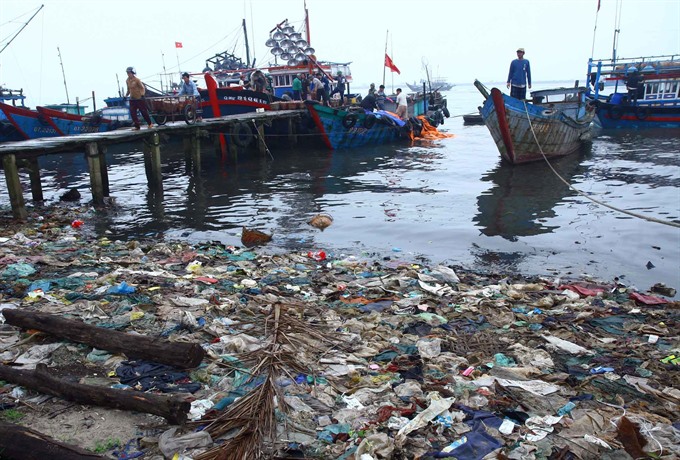 Society
Society

Marine ecosystems play a very important role in mitigating the impact of natural disasters but unsustainable socio-economic development has contributed to their further deterioration, experts have warned.
 |
| Pollution at a fishing port in Gio Việt Commune, Gio Linh District in central Quảng Trị Province. Human production activities, including natural resource overexploitation, unsustainable aquaculture and industrial production, along with the effects of climate change have been damaging maritime ecosystems in Việt Nam. — VNA/VNS Photo Hồ Cầu |
HÀ NỘI — Marine ecosystems play a very important role in mitigating the impact of natural disasters but unsustainable socio-economic development has contributed to their further deterioration, experts have warned.
Việt Nam is well-known for its diversified marine ecosystems with abundant and endemic varieties and genes of creatures. Its marine ecosystems includes 155,000 hectares of mangroves, 1,300 square kilometres of coral reefs, 500 sq.km of lagoons, 16,000ha of seaweed and algae ecosystems, intertidal areas and estuaries.
The Institute of Oceanography under the Việt Nam Academy of Science and Technology said the mangrove forest system plays an important role in protecting seashore, preventing winds and storms, reducing landslide and erosion. It also provides valuable wood products and is home to many kinds of valuable and rare bird species and animals.
However, the marine ecosystems have been diminishing remarkably and deteriorated over the past decades.
In the past five decades, Việt Nam lost 67 per cent of total area of mangrove forest in comparison with 1943. During 1943-1990, the rate of forest lost was 3.266ha per year and the figure increased to 5.613ha per year by 2012.
The seagrass beds and coral reefs have also been diminishing over the last few decades.
According to a survey released by the Natural Resources and Maritime Environment Institute in 2014, only 1 per cent of the 1,300 sq. km of coral reefs along the coastline is in good condition. The coral coverage fell sharply by 30 per cent in 1993-2004.
The survey also found that the aquatic creature volume caught on every hectare of lagoon fell by 50 per cent in comparison with the last decade. The seaweed cover in the central coastal province of Khánh Hòa has shrunk by 80ha per annum.
Associate professor Nguyễn Chu Hồi from the Hà Nội National University said about 15-20 per cent of area of coral reefs were lost in the past 15 years, mostly areas inhabited by people such as Hạ Long Bay in northern Quảng Ninh Province and central coastal provinces.
It would lead to the reduction of the biodiversity and quality of sea environment, he said.
The recent seawater pollution off the four central coastal provinces of Hà Tĩnh, Quảng Bình, Quảng Trị and Thừa Thiên-Huế, which was caused by toxic wastewater released by a Taiwanese-owned steel company, had certain impact on the marine ecosystems, he said, adding that it took time for recovery.
The institute said increasing human population, which leads to a higher demand for ecosystem services, has put pressure on the maritime ecosystems.
Human production activities, including natural resource overexploitation, unsustainable aquaculture and industrial production, and climate change have also been damaging maritime ecosystems.
Human production activities, including natural resource overexploitation, unsustainable aquaculture and industrial production, and climate change have also been damaging maritime ecosystems.
Việt Nam lies to the west of the East Sea and touches the sea in three directions, with a long coastline of over 3,200km and territorial sea of more than 1 million square kilometres, which is triple the area of its mainland.
The Prime Minister in 2010 approved the maritime protection area (MPA) development program, under which Việt Nam would have 16 MPAs with the total area of 169,617 ha by 2020 and at least 0.24 per cent of territorial waters belonging to MPAs, while 30 per cent of every MPA area would be put under strict control.
The Law on Marine and Island Resources and Environment, which was passed by the National Assembly last year, takes effective from July this year. It is expected to provide a new method of managing marine and island resources in order to promote effective and sustainable exploitation and use of these resources and protect the marine environment. - VNS




